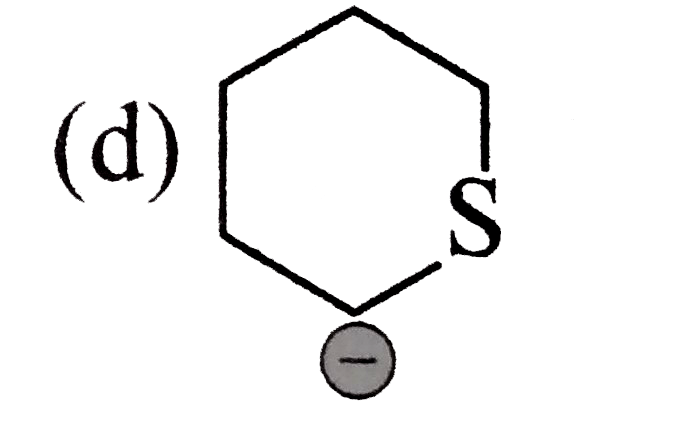In which of the following resonance is not possible ?
CH2=C=CH2
CH2=C=CHΘ
CH2=C=CH⊕
CH2=C=CH⋅
The correct Answer is:A
To determine in which of the given options resonance is not possible, we need to analyze each structure provided in the options. Resonance occurs when there are multiple valid Lewis structures (resonance structures) for a molecule that can be drawn by moving electrons around while keeping the positions of the nuclei fixed.
1. Analyze the First Option:
- The structure has a carbon atom with five bonds.
- Carbon can only form four bonds due to its tetravalency.
- Therefore, this structure cannot exist as it violates the octet rule for carbon.
- Conclusion: Resonance is not possible in this structure.
2. Analyze the Second Option:
- This structure allows for the movement of electrons.
- We can draw multiple valid resonance structures by shifting the double bonds and lone pairs.
- Conclusion: Resonance is possible in this structure.
3. Analyze the Third Option:
- This structure also allows for the movement of electrons.
- We can draw multiple valid resonance structures by shifting the double bonds and lone pairs.
- Conclusion: Resonance is possible in this structure.
4. Analyze the Fourth Option:
- This structure contains a free radical.
- Free radicals can participate in resonance as they can have unpaired electrons that can be delocalized.
- Conclusion: Resonance is possible in this structure.
Final Conclusion:
Based on the analysis, resonance is not possible in the first option due to the violation of the tetravalency of carbon, while resonance is possible in the other options.
Answer:
Resonance is not possible in the first option.
---
- The structure has a carbon atom with five bonds.
- Carbon can only form four bonds due to its tetravalency.
- Therefore, this structure cannot exist as it violates the octet rule for carbon.
- Conclusion: Resonance is not possible in this structure.
- This structure allows for the movement of electrons.
- We can draw multiple valid resonance structures by shifting the double bonds and lone pairs.
- Conclusion: Resonance is possible in this structure.
- This structure also allows for the movement of electrons.
- We can draw multiple valid resonance structures by shifting the double bonds and lone pairs.
- Conclusion: Resonance is possible in this structure.
- This structure contains a free radical.
- Free radicals can participate in resonance as they can have unpaired electrons that can be delocalized.
- Conclusion: Resonance is possible in this structure.
Based on the analysis, resonance is not possible in the first option due to the violation of the tetravalency of carbon, while resonance is possible in the other options.
Resonance is not possible in the first option.
Topper's Solved these Questions
- GENERAL ORGANIC CHEMISTRY-IBook:RESONANCEChapter:GENERAL ORGANIC CHEMISTRY-IExercise:EXERCISE-1 PART-III (MATCH THE COLUMN)
Explore 1 Video
- GENERAL ORGANIC CHEMISTRY-IBook:RESONANCEChapter:GENERAL ORGANIC CHEMISTRY-IExercise:EXERCISE-2 PART-I
Explore 20 Videos
- GENERAL ORGANIC CHEMISTRY-IBook:RESONANCEChapter:GENERAL ORGANIC CHEMISTRY-IExercise:EXERCISE-1
Explore 16 Videos
- GENERAL ORGANIC CHEMISTRY IIBook:RESONANCEChapter:GENERAL ORGANIC CHEMISTRY IIExercise:Part-III: Section-5: Matching List Type
Explore 1 Video
- HYDROGEN AND ITS COMPOUNDSBook:RESONANCEChapter:HYDROGEN AND ITS COMPOUNDSExercise:INORGANIC CHEMISTRY(Hydrogen & its compunds Y environment chemistry)
Explore 33 Videos
Similar Questions
Knowledge Check
Resonance is not possible in
A B
B C
C D
D
Resonance is not possible in:
A B
B CCH2=CH−ClD
CCH2=CH−ClD
In which of the following, will resonance be possible?
ACH2=CH−CH2−CHOBCH2=CH−CH=OCCH3COCH3DCH2=CH−CH2−CH=CH2
Which of the following resonance form is most stable ?
View SolutionIn which of the following, resonance of −NH2 group is possible ?
View SolutionWhich of the following exhibits resonance?
View SolutionWhich of the following resonating form is not correct for CO2?
View SolutionWhich of the following resonating structures is not correct for CO2 ?
View Solution

